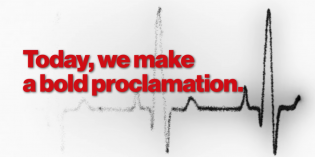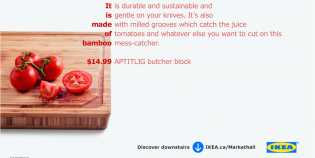Rahaf Harfoush describes herself as a new media maverick, though she sometimes jokes she’s going to change the title. The “maverick” moniker was famously adopted by John McCain and Sarah Palin during the U.S. presidential election, and Harfoush invested considerable time and effort in a battle to defeat those mavericks last fall.
That battle, in which Barack Obama defeated John McCain, was first and foremost a political triumph, but Obama’s campaign has also drawn raves from marketing and communications experts for its near flawless execution; Advertising Age named him 2008 Marketer of the Year weeks before the Nov. 4 election.
It was perhaps inevitable the country’s first BlackBerry-dependant president would use technology to defeat a competitor who admitted to never using e-mail; Obama proved definitively that, when smartly deployed, social media can give a candidate (or marketer) a monumental advantage over rivals either unwilling or unable to take advantage of the power they possess.

Photo: Jesse Morgan
Obama’s campaign has been dissected and widely celebrated by new media champions, and for its final few months, Harfoush had a front-row seat at Obama HQ in Chicago to watch it unfurl. “I went down to Chicago to learn from the best social media minds,” she says. “People like [Facebook co-founder] Chris Hughes, [Obama’s website designer] Scott Thomas, and [the campaign’s new media director] Joe Rospars were doing unbelievable things with this campaign, and I wanted to be a part of it.” Harfoush volunteered on the now famous My.BarackObama.com as a community manager and did everything from approving groups and troubleshooting user issues to phoning supporters and thanking them for their efforts.
“Mainly I just listened, observed and soaked it all in,” she says. “And knew I was witnessing an amazing moment in history.”
Harfoush is among many recent graduates into the business world who can truly say they grew up digital, but she also possesses an impressive intellect and is a superb communicator. With an instinctual appreciation for around-the-clock connectivity, not only does she understand new media, she can explain to those who don’t how it is changing the world—or at least their marketing.
She saw it first-hand in Chicago, and now people want to learn from her. Since returning to Toronto after the election, she has given talks at OCAD and Rotman, written most of a book about the campaign (to be published in May) and has landed a one-year gig with the World Economic Forum in Geneva.
So just where did this self-described “maverick” begin the political marketing odyssey that landed her posh speaking engagements and a deal for an Obama insider book called (of course) Yes We Did—not to mention a cool new gig in Switzerland?
Just turned 25, the Damascus-born Harfoush graduated from the Ivey School of Business in 2006 with an Honours in Business Administration. While still in school, she interned at Nestlé and Cundari, and later worked for author Don Tapscott, first on his seminal work Wikinomics and later in 2008 on his most recent book Grown Up Digital, by which point she had started her own consulting business. “Her first assignment on Wikinomics was to line up interviews with impossible people,” says Tapscott. “She got just about everyone she went after—real smarts, persuasiveness and tenacity.”
By last August, Harfoush, who had been studying the Obama campaign for Grown Up Digital, got so fired up by Will.i.am’s Yes We Can video and the burgeoning Obama-mania that she got in her car with her boyfriend and drove to Obama headquarters in Chicago.
“I made sure [Obama] was the real deal before I went,” she says. “I knew I could help with e-mail analytics; from useability to language audits, I was very, very connected to people in my [digital social media] community.”
While working as a research coordinator for Grown Up Digital—she drafted parts of the chapter on social media—Harfoush got to know Hughes, Obama’s director of online organizing.
Hughes arranged to have Harfoush join the Obama new media team. “I was in geek heaven,” she recalls. “This was a once-in-a-lifetime, with smart, young, vibrant people everywhere. I had an internship at Barack University.”
Harfoush now found herself at the beating heart of a marketer’s dream. “[This is the] new age of marketing, which focuses on creating authentic relationships between brands and consumers through conversations,” she says.
And that’s exactly what Obama and his new media team did. They used social media tools to have far richer conversations with volunteers and voters than any candidate in history, never mind John McCain.
The Obama campaign was delivering a constant stream of information to volunteers and would-be voters alike, creating a near-constant connectedness to the campaign and, by extension, the candidate himself: voters could see Obama on TV every day jetting around the country, but the new media team made those voters feel like he was in their community as well.
Based on what she saw and learned over her three months at Obama HQ, Harfoush identified seven key factors behind the success of the campaign, which she outlined her in speech to OCAD in January.
The first was redefining engagement. The Obama campaign had three million Facebook entries compared with McCain’s 600,000; a million entries on MySpace compared with 22,000 for McCain; 1,824 videos up on YouTube compared with 330 for McCain. “And Twitter? Twitter had 20 million views—10 times the amount for McCain’s—and 140,000 followers to his 4,000,” she says. “They used social media to create new ways for people to support the campaign and to engage.”
The second task was to “convert low-end” users via hypersegmented e-mails. “We had over 13 million addresses, customized via geography, the issues… and donation history—how much? How often?”
Low-end users were those who had subscribed for e-mails but were not actively organizing for the campaign. “The Obama team used creative e-mail contests and donation campaigns to nudge those people to participate, thus converting them from passive e-mail readers into campaign supporters,” she says.
The third strategic element was marketing 101: “We facilitated existing behaviours. We made it easy to do things, helped them do it better and faster,” she says. Which is where the iPhone applications come in. Designed by campaign IT wizard Jascha Franklin-Hodge, the groundbreaking applications did the campaign’s communications grunt work, distributing lists of voters for volunteers to call, right on their iPhone, with battleground states the priority.
“The Obama campaign facilitated existing behaviour by making it easy for supporters to actively support the campaign no matter where they were or what they were doing.”
Volunteers could report their calls in real time, and campaign HQ would follow up within hours to congratulate and fire up successful volunteers. A constant media stream worked wonders in building Obama brand evangelism: “Our RSS feeds and livestream video never stopped,” says Harfoush. “Everything was local, in bite-sized chunks. The goal was to have the volunteer be an instant informed spokesperson.”
“Incenting the right actions” was the fourth key objective, according to Harfoush. “Everything hinged on the ‘making a difference’ page [on My.BarackObama.com], where we had an activity index.” The index scored a volunteer’s activity, inspiring creativity, shared thinking and a little healthy competitiveness.
The upshot? The most valuable volunteers were encouraged to report and recruit even faster. High-value users, once they hit a threshold score established by HQ, could participate in a campaign conference call as a visiting VIP.
“Even if you made 100 calls, if you didn’t do anything else for a while, your score would drop, motivating people to come back and do more campaign activities.”
The fifth New Media task was “personalize the mission.” The campaign website posted a personal fundraising widget, asking “why is supporting Barack Obama important to you?”
It was both a fundraising and dialogue tool. People could call a friend or a neighbour to explain their personal reasons for voting for Obama—an Iraq exit plan that will bring a loved one home from the war sooner, for instance—and then ask for their support. “It allowed supporters to use their own passions and experiences to support the campaign.”
Sixth on Harfoush’s list: “empowering co-innovation.” My.BarackObama.com had downloadable tools ready to upload event coordinates for everything from Wii tournament fundraisers and poker games to art gallery showings and film documentary premieres. One woman got her friends to dress up like voting machines on Halloween to remind people to vote. The point was, people were free to create their own events to raise awareness and remind people to vote. “They opened it up and trusted people to know what would work best in their communities,” explains Harfoush.
And finally, the last task? “Embrace the unexpected,” Harfoush says. “We took ideas and ran with them, like the Halloween ‘Yes We Carve’ campaign and the graffiti murals.” “Yes We Carve” was a site created by people who had nothing to do with the campaign; it included Obama-themed pumpkin stencils so supporters could turn their jack o’lanterns into glowing Barack Obama ads.
“When you involve people in co-creating your brand you lose some control, but that’s not always a bad thing,” says Harfoush. An even better example was the Will.I.Am
Harfoush still recalls election night with wide-eyed wonder months later. “There was a long moment’s silence as CNN made the announcement when the California polls closed. ‘We actually did it,’ I remember thinking. He’s president. We had ownership of this.’ We all asked ourselves: ‘What do we do now?’”
Obama gave a quiet speech, just for the campaign HQ workers. “It was very, very humble. He said what a privilege it had been for him and how much he respected the relationship he had with us. We were so proud of him, bursting with unconditional affection for him. And the whole time, we never saw any temper from him, never heard any stories. And Michelle [Obama] was always there.”
In a delightful turn of fate, Harfoush’s voice—heard by the hundreds of millions who tuned in to hear Obama’s victory speech at Grant Park in Chicago election night—was on the public address system, welcoming the hundreds of thousands to the final triumph live. “I met Spike Lee there,” she says, shaking her head. “Then I made myself observe; I was the scientist, watching history.”
And then, suddenly, it was over. “There was a feeling like: what do we do next? I’d documented everything; I journaled, I have still photos and video. And it’s all there in my tweets. Everything.”
The experience—the observing, documenting and learning—has paid off handsomely for Harfoush. Already earning a reputation for her new media expertise before she went to Chicago, people are keen to hear about her experiences at Obama HQ. Her book Yes We Can, believed to be the first from a campaign insider, will detail her lessons and insights gained from being on the ground in HQ.
After hearing her speak at OCAD, GWP chief executive Bruce Philp brought Harfoush to his agency to talk with his team and share her insights as they worked on a new media strategy for client ING.
“She had a front row seat for what is the single greatest marketing experiment in the social media space ever,” says Philp. “They invented stuff, and regardless of what her role was, she experienced it and it makes her very valuable.”
Tapscott isn’t surprised by her ascendance. “She is extraordinarily smart, a consummate networker and as effective as any young person I’ve met at building her own brand,” he says. “She is also fearless, which goes a long way on stage and pretty much anywhere else.”
Harfoush is in Geneva now, the World Economic Forum’s new associate director of the Global Cooperation Initiative, working on the development of the Forum’s online community platform.
She explains on her blog: “The idea is to create a community that can continue to execute on the Forum’s mandate to improve the state of the world. Cool, huh? It will allow governments, NGOs and corporations collectively work together to help solve some of the world’s biggest problems.”
An impressive, though perhaps daunting proposition, but Harfoush is ready. “It’s not a project without challenges, but for right now, let’s bask in the unmarred potential of a new opportunity.”
BRENDAN HOWLEY is an editor at Redwood Custom Communications and the author of The Witness Tree










